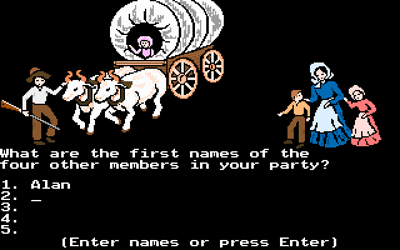Thirtieth Anniversary of the Apple II
Monday is a big day. The Apple II was first introduced to the world on April 16, 1977. For all practical purposes, it was the first personal computer, and it was designed essentially by one person.Appreciation for Apple II really goes beyond whether you're an Apple person or not. Without this machine, there would likely be no Mac, no Windows, no desktop environments for Linux. Steve Wozniak created something the world had never conceived of before, an experience he talks about in iWoz.
It's sobering to consider how distant in technology time the Apple II is from the Mac Pro or the iPhone. Many technology companies are lucky if they ever ship even a single product with worldwide recognition and last more than a few years.
The original announcement predates me, but I do have one strong memory of the Apple II. In my elementary school, we'd take a trip to the Apple computer lab every Tuesday and Thursday. In theory, we were there to do work or something, but we were really in it for the games.
The game, of course, was Oregon Trail. So help me, I lost more oxen in that river and laid claimed to several orders of magnitude more meat than my little character could ever carry back, but it was endlessly fun in all of its green monochrome glory.
The best part may have been that you could name your characters after your friends, and then yell at them across the room when things happened to them in the game.

As the school year would wind down, the teachers wouldn't even bother trying to get us to do the math work, but would just let us play games on the Apple IIs. I don't think they realized it, but that was a signal that you had reached the end of a long journey — the whole school year was finally over. Unbelievable happiness on the cusp of the freedom of summer.

Thirtieth Anniversary of the Apple II
Posted Apr 14, 2007 — 9 comments below
Posted Apr 14, 2007 — 9 comments below








Chris Lundie — Apr 14, 07 3907
http://youtube.com/watch?v=uCnX57p-eHo
Richard Neal — Apr 14, 07 3908
Frank 'viperteq' Young — Apr 14, 07 3911
Reg — Apr 14, 07 3912
My "mentor" spent the time keying in assembly to make the speaker click tones, getting it to play rudimentary tunes. Then we examined various Integer BASIC programs, by typing LIST, altering entries on the (numbered 10, 20, 30) lines, and using PEEK and POKE at memory locations to affect the graphics display.
I remember we thought we were clever in getting a "hi-res" image to save using only 33K instead of the normal 34K, by giving a particular POKE command first. (I can almost remember the address now: POKE -13635,33 or something.)
Such primitive computing by today's standards, but you can imagine the thrill for a young person.
I also remember the school principal coming by that library room one time and giving his expert appraisal: "all hot air."
Later, at a P&C meeting, a parent had asked a question: "With computers starting to appear, should the school hold classes that taught how to type on them and use them?"
His response: "We aren't raising secretaries at this school."
Such a stupid, stupid man. He used to be a sports teacher, elevated to school principal by some absurd education system, but he wasn't alone in being ignorant and afraid of the new technology.
I had far more respect for that Apple ][ than I did for any of the teachers, and its genius was the best thing about going to school] than I did for any of the teachers, and its genius was the best thing about going to school.
Charles — Apr 15, 07 3917
Oddly enough, unlike Applesoft Basic or Integer Basic, Atari Basic absolutely prohibited programs from modifying their own code. I worked for weeks and weeks trying to figure out a way to get their cute little self-modifying code trick to run somehow on the Atari, but it just would not work. I told them that all the programs I was assigned to port used the same self-modifying code trick, so the code would not port, and the project was dead. They insisted I find a way to get the Atari to accept self-modifying code. I told them flat out, it was impossible without rewriting the Atari Basic interpreter, and that was not going to happen. They seemed rather upset that they'd paid me money for several weeks of coding that ended up being several weeks of research and no program code resulted. That was my first real experience with a Project From Hell.
Bill Coleman — Apr 16, 07 3927
The original announcement predates me...
Gosh, Scott, you're younger than 30?
It's hard to get a clear perspective on the impact of the Apple ][ from today's world. Today, just about everyone has computers, and many had them for sometime.
The earliest personal computers sold were backplane types -- the box consisted of a interconnect bus and several connectors, and a power supply. Some units had front panels. The real guts of the system came from the slide-in boards. The Altair 8800, IMSAI 8080, SWTPc 6800 and the machines that followed were basically all of this type.
There were also single-board computers (SBCs), usually not much more than a hardware evaluation board from the microprocessor manufacturer. The KIM-1 is probably the most famous of this type -- it had a hexadecimal keypad an a six-digit seven-segment display. The Apple I was also an SBC.
The Apple ][ hybridized these two ideas. The motherboard had the main components, but a bank of connectors allowed for expansion. A case, keyboard and efficient power supply rounded out the package. All you needed was a monitor and a cassette recorder (to store/load programs) to be programming.
About the only computers even close to this form factor at the time were the Processor Technology SOL (an excellent product, but expensive), and the Sphere (a product plagued with internal signal path problems, due to cost-cutting in the design).
Another brilliant part of the design was the inclusion of a large ROM, with BASIC language available. In the days before the floppy disk drive was common, this was important -- you didn't have to wait 4-5 minutes for your BASIC interpreter to load from cassette tape.
Interestingly, it was exactly this type of design that IBM chose to replicate almost exactly four years later, with the original IBM PC. Of course, they didn't have Woz's brilliance for eliminating needless circuitry. The IBM Monocrome Display Adapter (MDA) had more components than the entire Apple ][ mother board -- and it didn't even do color!
Apple stopped selling the Apple II product line in the early 90s, so the product has like been discontinued longer than it was in production at this point.
Still, the success of the Apple II allowed Apple to go forward with the Mac, which changed the computing world fundamentally, although it took many years to see that revolution through. Perhaps Apple has a few more revolutionary ideas up its sleeves....
Tim Buchheim — Apr 16, 07 3929
And before that, I learned to type (and some programming in LOGO and BASIC) in my elementary school's Apple IIe lab.
Great machines.
BTW, that screenshot is most certainly not from the Apple II version of Oregon Trail. (The original Apple II only had only 6 colors for its 280x192 "high res" graphics mode: black/white/green/purple/orange/blue, with severe restrictions on which colors could appear next to each other.) The reference to the "Enter" key is another clue. (The Apple II version referred to the Return key. Apple has always labeled that key "return" rather than "enter".) See the top-most (mostly green) screenshot in the Wikipedia article for an actual screenshot of the Apple II version of the game.
Scott Stevenson — Apr 17, 07 3931
Yep, I know. I couldn't find any true monochrome screenshots without eight-page-long licenses attached.
Chinmoy — Apr 17, 07 3933